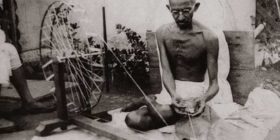“A flag is a necessity for all nations. Millions have died for it. It is no doubt a kind of idolatry which would be a sin to destroy. For, a flag represents an Ideal. The unfurling of the Union Jack evokes in the English breast sentiments whose strength it is difficult to measure. The Stars and Stripes mean a world to the Americans. The Star and the Crescent will call forth the best bravery in Islam. It will be necessary for us Indians – Muslims, Christians, Jews, Parsis, and all others to whom India is their home – to recognize a common flag to live and to die for,” Mahatma Gandhi once said.
And while millions of Indians look up to the tricolour with pride and patriotism, very less is known about the man who designed the flag: Pingali Venkaiah, a freedom fighter.
Born on August 2 1878 in Bhatlapenumarru in Andhra Pradesh, Pingali was considered an authority in geology and agriculture, according a report in The Hindu.
He is also said to have been a polyglot, and was proficient in several languages including Japanese and Urdu.
India Today reported that he had been “nicknamed ‘Diamond Venkaiah’, as he was an expert in diamond mining. He was also called ‘Patti Venkaiah’ (Cotton Venkaiah) , because he dedicated most of his time researching staple varieties of cotton and did a detailed study on a variety called Cambodia Cotton.”
During the freedom struggle, a Live Mint report states, Pingali started researching national flags and their designs. Pingali and Gandhi had first met in Africa when the former was serving in the British Army; Pingali was just 19 then. In 1921, Gandhi asked Pingali to design a national flag, to which he agreed.
The Indian National Congress officially adopted the flag a decade later in 1931.
According to a piece by Veejay Sai for TNM, Gandhi at the time wrote of Pingali’s hard work in his paper ‘Young India’:
“We should be prepared to sacrifice our lives for the sake of our National Flag. Pingali Venkaiah who is working in Andhra National College Machilipatnam, has published a book, describing the flags of the countries and has designed many models for our own National Flag. I appreciate his hard struggle during the sessions of Indian National Congress for the approval of Indian National Flag. When I visited Vijaywada, I asked Mr Venkaiah to prepare a two coloured flag with red and green colours along with a Chakra symbol and obtained it within three hours from him. Later we had decided to include the white colour, also the colour that reminds of truth and non violence,” he said.
Following this, Pingali earned the moniker “Jhanda Venkaiah”.
Sadly, the man credited with designing the national flag that would eventually be adopted by the world’s largest democracy, died in penury in 1963.
In 2009, the government released a postage stamp in his honour. His name was also recommended by the Andhra Pradesh government in 2012 for the Bharat Ratna awards, the country’s highest civilian award. In 2015, Venkaiah Naidu unveiled a statue of Pingali at the All India Radio building in Vijayawada.
But he still continues to be largely forgotten by not just the leaders but also the masses.
Pingali was survived by two sons and a daughter. In 2001, as the Live Mint report points out, a controversy erupted when an unknown woman named Poornima Devi claimed to be Pingali’s daughter. In fact, a Telugu Desam Party MP also mentioned Poornima Devi in the Rajya Sabha stating she was living in poverty. However, after the freedom fighter’s family lodged a criminal complaint against her, she admitted that she had lied about the claims and had done it “only out of affection”.






Leave a reply